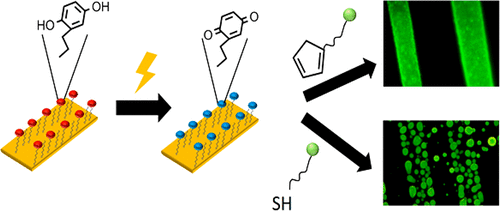Stimuli-Responsive Functionalization Strategies to Spatially and Temporally Control Surface Properties: Michael vs Diels–Alder Type Additions
NANBIOSIS Unit 6 Biomaterial Processing and Nanostructuring and Unit 3 Synthesis of Peptides collaborate in a research whose results are published by The Journal of Physical Chemistry B
Stimuli-Responsive Functionalization Strategies to Spatially and Temporally Control Surface Properties: Michael vs Diels–Alder Type Additions
Stimuli-responsive self-assembled monolayers (SAMs) are used to confer switchable physical, chemical, or biological properties to surfaces through the application of external stimuli. To obtain spatially and temporally tunable surfaces, we present microcontact printed SAMs of a hydroquinone molecule that are used as a dynamic interface to immobilize different functional molecules either via Diels–Alder or Michael thiol addition reactions upon the application of a low potential. In spite of the use of such reactions and the potential applicability of the resulting surfaces in different fields ranging from sensing to biomedicine through data storage or cleanup, a direct comparison of the two functionalization strategies on a surface has not yet been performed. Although the Michael thiol addition requires molecules that are commercial or easy to synthesize in comparison with the cyclopentadiene derivatives needed for the Diels–Alder reaction, the latter reaction produces more homogeneous coverages under similar experimental conditions.









